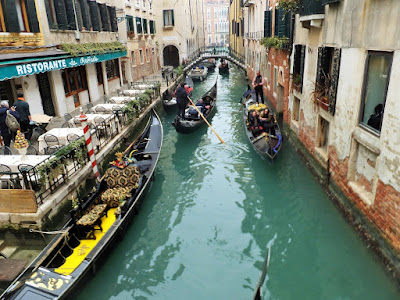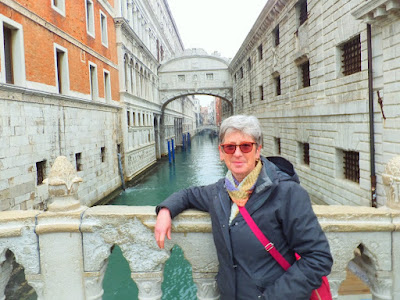 |
| Lennon lyrics shine on a Bologna street. |
 |
| Our dinner in Bologna includes the best boloney sandwiches ever. |
Bologna's Piazza Maggiore is hopping on the Friday evening of our visit. Before we find the Tourism Office, I stop to admire the Fountain of Neptune, one of the city's symbols. It seems everyone is here, getting primed for this final weekend of Carnivale.
 |
| The Flemish sculptor known as Giambologna designed the Fountain of Neptune in Bologna. |
Following the "three hours in the heart of our city" route that is suggested on the map, we manage to cover a lot of ground. We also leave plenty of sites to discover the next time we visit Bologna.
 |
| This typically stunning building is located along via dell'Indipendenza in Bologna. |
 |
| The Basilica of San Petronio in Bologna contains the world's largest sundial as well as this beautiful altar. |
If I think I may come back to Bologna, I'm certain I'll return to Florence. Our three days here aren't enough to see everything. We've barely dipped our toes into the Renaissance riches that abound here.
 |
| This replica of David stands in Piazzale Michelangelo in Florence. |
Our apartment in Florence is ideally situated in a quiet neighborhood at the base of Giardino Delle Rose, the mountain that Piazzale Michaelangelo sits atop. Once we settle into our excellent lodgings, we walk up to the plaza that contains wonderful views as well as one of the city's two replicas of David. The original David is located in the Gallerie dell'Accademia, a museum that we don't have time to visit this trip, unfortunately.
 |
| This guy seems to be stepping off the Grazie bridge in Florence. |
 |
| Packed with people and jewelry stores, we only bother crossing Ponte Vecchio once during our visit to Florence. |
 |
| This replica of David stands in Piazza della Signoria (Duomo Square) in Florence. |
 |
| Filled with statues, Piazza della Signoria is Florence's main square. |
 |
| Sandro Botticelli's The Birth of Venus is displayed at the Uffizi Gallery in Florence. |
 |
| This sculpture of Hercules slaying a centaur is an important example of an ancient statuary that was completed in the modern era. It is on display at Uffizi Gallery in Florence. |
 |
| Caravaggio's painted shield depicting Medusa was given to Grand Duke Ferdinando by Cardinal Francesco Maria del Monte in 1598. It is on display at Uffizi Gallery in Florence. |
The next day, we're off to visit Palazzo Pitti. This vast palace was once owned by the Medici family, who turned a mere castle into one of Florence's most important art museums. The Palatine Gallery, the Royal Apartments, the Treasury of the Grand Dukes, the Gallery of Modern Art, and the Museum of Costume and Fashion, are all housed inside the Pitti Palace. It's smart to look up: The ceilings here are amazing.
 |
| The ceilings at the Pitti Palace in Florence are as glorious as the artwork contained there. |
 |
| This marble sculpture entitled "The Young Michelangelo" is by Emilio Zocchi. It is on display at Pitti Palace in Florence. |
Adjacent to Pitti Palace is Boboli Gardens, the largest monumental green space in Florence. One needs a separate ticket to visit Boboli, which is more open-air museum than garden. It was created over a 400-year period in the 15th through 19th centuries. Originally designed by the Borgolo family, the garden was expanded and designed by the Medici family. Included are an amphitheatre, fountains, a rampart built by Michelangeo, and, if you visit in the right season, flowers. Amazing views await those who climb to the top level.
 |
| Neptune's fountain in Florence's Boboli Gardens is nicknamed "The Fork." |
 |
| Giotto's Bell Tower and the Cathedral of Florence are seen from Boboli Gardens. |
We seem to be the only visitors to Museo Archeologico, although soon a school group arrives, which provides a soundtrack of chatter and giggles to our exploration. The museum's Egyptian Collection is Italy's second most important after the one in Turin.
 |
| Mummies and other relics from Egypt are on display at Florence's Archaeological Museum. |
 |
| This piece is on display at the Archaeological Museum in Florence. |
Our trip to Italy is nearing its end. We'll return to France via train to Genoa, Flixbus to Marseille, and another train home. We're proud that we've done this whole trip via ground mass transit. Far less stressful than driving, parking, and planes, we'll certainly be opting for trains and buses for many of our future adventures.
































